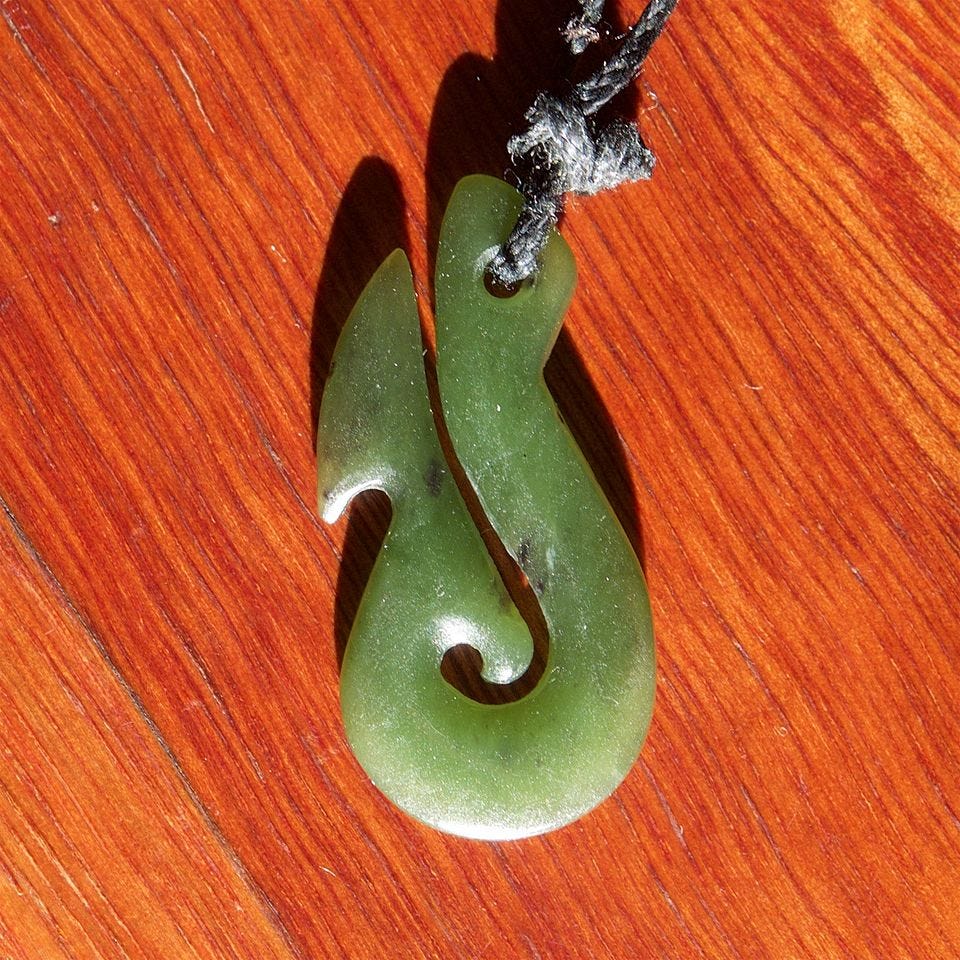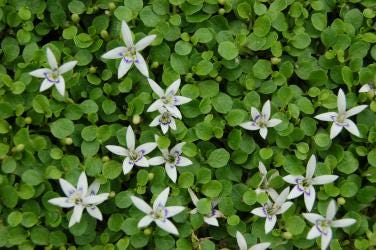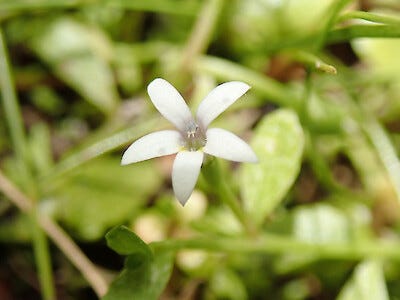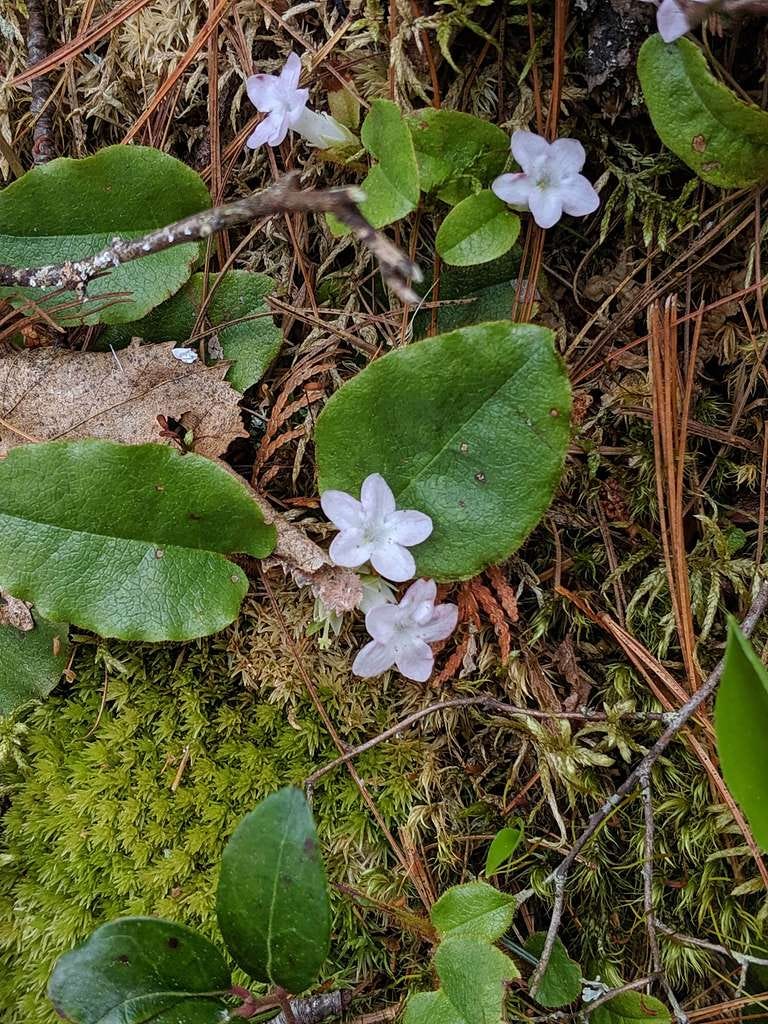ALSO KNOWN AS: Lobelia ionantha
From a distance
A plant that’s part of turf
They grow in kettleholes that empty and fill with water throughout the year
Native to Te Waipounamu, or South Island New Zealand
So maybe this one is more about land than it is about plants. We see the land through it, rather than observe its intricacies through the culture or the science around the plant itself. But maybe that’s by the plant’s design. This plant is ephemeral and small and it grows in lowlands where water frequents or pools. The little white flowers have yellowish green markings at the sinus - where the style sits and the bees descend. Like the painted tears of a pierrot clown, the yellow is dotted with purple. Five petals three down and two up. With basal leaves that are succulent. And yet they sometimes have the smallest hair, lining them like little animals, from stem to leaf.
The Hypsela rivalis grows on the South Island, or Te Waipounamu, of New Zealand. Even though it’s the biggest of the New Zealand archipelago, it is the least populated.
Of Leaves and Spoons
Its names are shrouded in science and culture so local I am far away from it, writing about it here. Even if I did know the name I wouldn’t really know the meaning. They were once related to cardinal flowers. Now they’re related to bell flowers. They are part of the Lobelia family, a subgroup of the Campanulaceae or bellflower family, a common and lovely, but unpopular species, you’ve probably seen somewhere but don’t know the name of.
They can grow in ephemeral bodies of water. The reproductive parts are male and female, and they reproduce really quickly, set seed, and then are gone because they must release their seeds long before the waters rise again.
There isn’t much information about this plant. There’s only so much we can know unless we are there at exactly the right time, or unless we live there and watch the place breathe, in and out, with water. But the environment teaches us how the plant works.
This isn’t a common bell flower. It creeps, lying on the ground and spreading. Where the leaves grow the roots grow. It has these spontaneous blooms that seem to grow straight from the soil during the months between October and April. Their fruits are speckled and pink and the shape of pomegranates big enough for fairies to harvest in the late summer of the southern hemisphere. And their flowers don’t look like bells at all, they splay open and up. Look close and see their style fused in a minuscule lattice, condensing at the stigma.
These are tiny stars in the cold turf. Turf is common in this type of landscape, these are common in arctic and subarctic climates where the plants stay smaller generally and close to the earth. Turf is not a soccer field or your bluegrass lawn, it’s an actual ecosystem where small herbaceous plants only grow as a net of very low plants.
The Stars the Glacier Left
I live in probably the most paved-over land in the world. I sometimes wonder if a stream once trickled below me, if a swamp has been diverted to allow this apartment complex to be here. What fox lived here? What tree fell here? What people were born here, where did they die? And yet the island still stands, by the grace of stones, that ancient life that compounded to hold us up. Edgar Allan Poe said of the grid, that it destroyed the beauty of the island of Manhattan. I’m not being romantic or essentialist when I tell you that the island of Manhattan was, most certainly, beautiful when trees replaced its buildings, when ponds and rivers fed its life. How it must have changed as it moved to the windbound Long Island, overlooking the long ocean, that from a straight line from the Rockaways, does not meet another land mass until it hits Haiti, way down in the Caribbean.
If you had asked me the similarities between New York City and Te Waipounamu, the southernmost island of New Zealand, I would not have been able to tell you. But glaciers write stories on the land and the plantlife.
Kettleholes are common in glaciated landscapes both in New York and Long Island from the last ice age that retreated 10,000 years ago. Chances are you’ve seen them too, sometimes they’re called ponds. But like so many wetland types, there is little common knowledge about them, and often they have been drained because of their inconsistency - like so many wetlands. You may be standing on a wetland now and not know it. But wherever they are they host a range of species that need a wet, though not entirely aquatic, environment. Some kettleholes fill and dry out seasonally depending on the environment they’re in. In the South Island many do this.
In New Zealand the plants that grow in kettleholes are called fork and spoon plants because the shape of their leaves changes depending on the season. Hypsela is probably the same, but its leaves are on the rounder side, like different shaped spoons, not so jagged as a fork - or even spork - requires.
The Hypsela rivalis can grow in ephemeral bodies of water like the kettleholes, the low field of stars this Hypsela are not seen by many because they weave the side of mountains or submerge themselves underwater. And when they bloom in those summer months, they’re lovely stars set in the bottom of a hole. If that’s the case, it is covered in water in the winter and on soil, exposed to the sun in the summer. Find them in open areas where there is little shade during their short-lived pollination.
Here amphibians lay eggs. Here, only the malleable survive.
This is a rare ecosystem only in that many people don’t know its name. Kettleholes are common wherever glaciers were, and our last ice age left a landscape pocked with many holes. Glaciers were in a lot of places. In a way it’s like a footprint of ice, but unlike footprints, it stopped moving. These blocks of ice calved from the glacier during its massive retreat. They were weighed down by the sediment build up and left behind. These giant iceblocks that pock a glaciated landscape with lakes and depressions are known as dead ice. But think of it as ice that wanted to stay. It broke off and waited for something, pressing the earth down with it. This is the place of some stubborn ice weighing it down. These depressions are generally porous, so they fill with a variety of plant species.
The island is called Te Waipounamu in Māori, which means island of greenstone, a distinctive stone that looks a bit like jade and is prized by the Māori who have a legacy of making tools, jewelry, and sacred objects out of this luminous green stone.
The island rises with glacial peaks like a long white spine. All along this central part of the island the Hypsela rivalis grows in a long line, from subarctic south to the central part of the island - as if backing away from the warmer north realms. Most of the land where it grows are plateaus with small depressions in the mountain range.
There are three main tribes or iwi – Kāi Tahu, Kāti Māmoe, and the historical Waitaha, the “water carriers” who came to the island, and the story of this mountainous landscape involves massive social change and environmental change, as much of the forest was burned by the Māori, and now remains almost treeless. In Māori mythology Te Waipounamu is known as the boat of Maui while the north island is the fish he caught. Long ago, these two land masses were fused together by land, but the glaciers rose the ocean levels and made them into islands, separating the mythical man from the fish.
I don’t know if this plant is edible. Many bell flowers are. They are high in vitamin C and their young shoots can be harvested to eat. The ethnobotany of the Hypsela rivalis is vague. It is threatened because of the competition of alien species and the development of its natural environment. It needs the wet soil, a soil so unsteady to human industry - to capital.
When I grew up I had a plastic anatomy figure that was a pregnant person. I loved it. I loved to take her apart and gently put her together, with the baby. Her skin was clear as glass, like a fairy tale. All things are kind of fairy tales in the moment when we first learn them. This is how this plant feels, so transparent and so mysterious at the same time. It doesn’t seem to hide anything and yet it can’t be this simple. It doesn’t have a story, this is one of its apparent purities. But, of course. It does have a story somewhere, lining these words, somewhere inside. Once they are pollinated their seeds grow in capsules that swell and turn from green to purples. They are slightly transparent. You can seed the small seed. This plant, just like the land it grows in, seems to take itself apart and put itself back together again.
Myth for hypsela rivalis
Text for myth and Glacial fractures and calving
Not to be confused with Lobelia fatiscens. These two used to be related.
Or mayflower, it also grows along the ground and has little white flowers.
Forager Friendly?
No, but they are so lovely, they are so little and ephemeral. Make a wish if you find them.
Sources
https://www.doc.govt.nz/nature/native-plants/kettle-hole-plants/
https://www.sciencedirect.com/science/article/pii/S0075951112000382
https://www.nzpcn.org.nz/site/assets/files/0/15/303/lobelia-ionantha.pdf
https://www.tandfonline.com/doi/abs/10.1080/00288250809509756
https://www.easthamptonstar.com/archive/nature-notes-kettleholes
https://en.wikipedia.org/wiki/Kettle_(landform)
https://www.geo.mtu.edu/KeweenawGeoheritage/Glaciers/Kettles.html
https://www.mackenzienz.com/52-reasons/pukaki-kettle-hole-track/
https://www.nzpcn.org.nz/flora/species/lobelia-ionantha/
https://teara.govt.nz/en/whenua-how-the-land-was-shaped/page-2
https://gobotany.nativeplanttrust.org/species/campanula/rapunculoides/
https://www.a-maverick.com/blog/south-island-peoples-maori-settler
https://biotanz.landcareresearch.co.nz/scientific-names/DF0813D3-3DD6-428B-A403-C881C37BBF82
https://www.tandfonline.com/doi/abs/10.1080/00288250809509756
Paradise Bronx, Ian Frazier

Hypsela scrapbook…
Keep reading with a 7-day free trial
Subscribe to What's That Plant?! to keep reading this post and get 7 days of free access to the full post archives.






